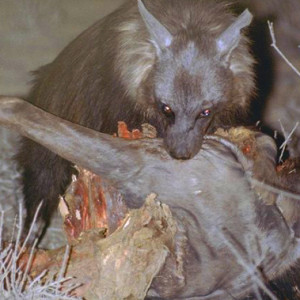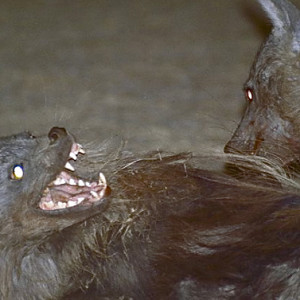The Yena
Some years ago I decided that I must try to develop an artistic side and so I went to a pottery class for a few weeks. At some point we had to make something to sit on a slab of clay. Since I had been working on hyaena scent marking behaviour in the kalahari desert at the time I decided to construct a hyaena latrine (piles of droppings) for my project. This raised a few eyebrows in the class! Any way, here it is, complete with an old chewed leg bone, some living-stone plants (Lithops), assorted leaves and a few hyaena turds. The turds should be pure white, but the glaze went awry in the kiln! They are white because hyaenas can eat and digest bone and pass out the remaining calcium as a fine powder. As an aside, Roman and Egyptian ladies used ground up hyaena droppings, and those of crocodiles, as a powder with which to whiten their faces.
The extra photos, taken at the time, show the brown hyaenas who produced the latrines. The map shows their location.
This is what Aberdeen University's Bestiary, written and illuminated in England around the year 1200 AD, has to say about the hyaena, or the Yena as it was sometimes known.
Of the hyena. There is an animal called the hyena, which inhabits the tombs of the dead and feeds on their bodies. Its nature is that it is sometimes male, sometimes female, and it is therefore an unclean animal. Since its spine is rigid, all in one piece, it cannot turn round except by turning its body right around. Solinus recounts many marvellous things about the hyena. First, it stalks the sheepfolds of shepherds and circles their houses by night, and by listening carefully learns their speech, so that it can imitate the human voice, in order to fall on any man whom it has lured out at night. The hyena also [imitates] human vomit and devours the dogs it has enticed with faked sounds of retching. If dogs hunting the hyena accidentally touch its shadow behind, they lose their voices and cannot bark. In its search for buried bodies, the hyena digs up graves. The sons of Israel resemble the hyena. At the beginning they served the living God. Later, addicted to wealth and luxury, they worshipped idols. For this reason the prophet compared the synagogue to an unclean animal: 'My heritage is to me as the den of a hyena.' (see Jeremiah, 12:8) Therefore those among us who are slaves to luxury and greed, are like this brute, since they are neither men nor
women, that is, neither faithful nor faithless, but are without doubt those of whom Solomon says: 'A double-minded man is unstable in all his ways'; (James, 1:8) of whom the Lord says: 'You cannot serve God and mammon.' (Matthew, 6:24) This beast has a stone in its eyes, called hyenia; anyone who keeps it under his tongue is believed to foretell the future. It is true that if the hyena walks three times around any animal, the animal cannot move. For this reason men declare that the hyena has magical properties. In a part of Ethiopia the hyena mates with the lioness; their union produces a monster, named crocote. Like the hyena, it too produces men's voices. It never tries to change the direction of its glance but strives to see without changing it. It has no gums in its mouth. Its single, continuous tooth is closed naturally like a casket so that it is never blunted.



Comments
Sign in or get an account to comment.


